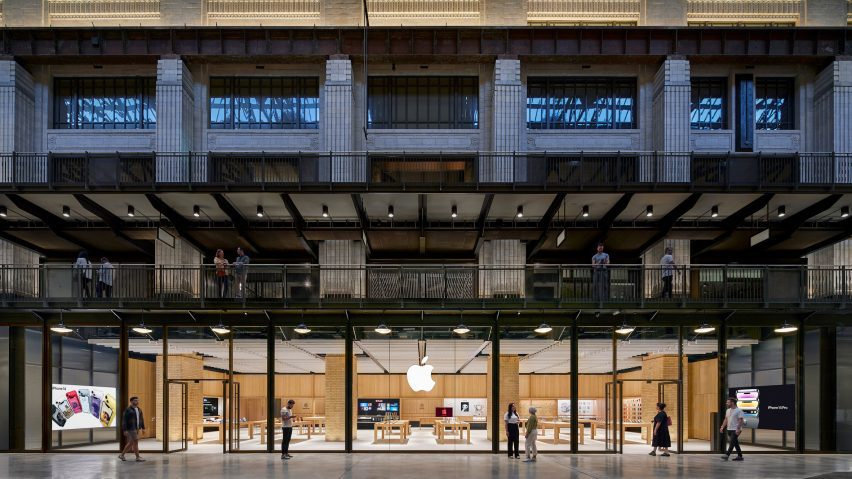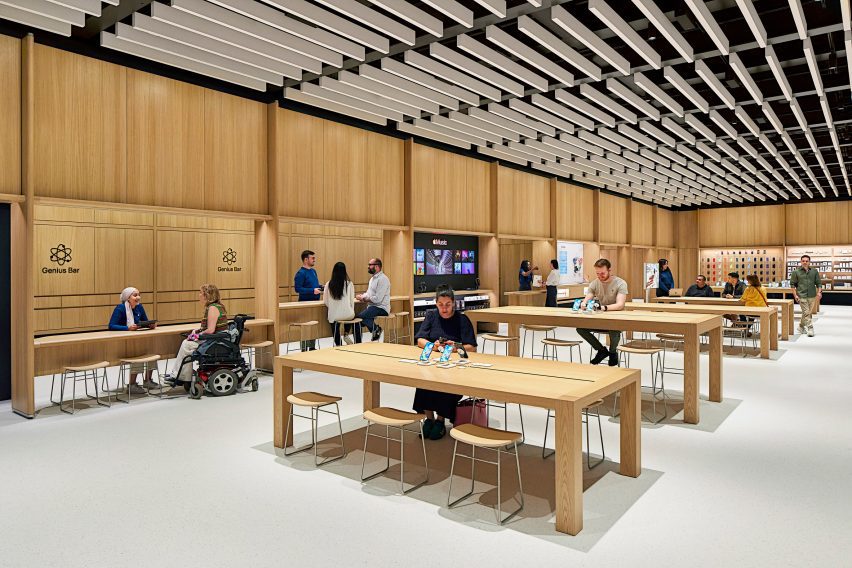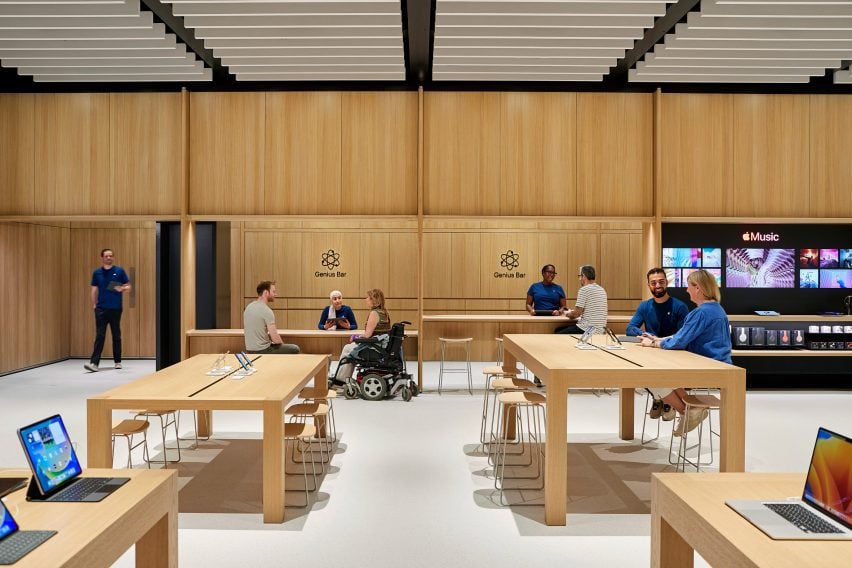
Apple partners need to be "absolutely committed to transparency" says retail sustainability lead
Apple is pushing for carbon transparency in the supply chain as it aims to reduce the impact of its stores, claims the tech company's retail sustainability lead Rebecca Cully in this interview.
Created as the latest "evolution of the Apple Store", Apple's recently opened location in Battersea includes several material innovations aimed at reducing the shop's carbon impact. These were sourced with transparency in mind, according to Cully.
"That transparency piece is one of the biggest beasts that we battle on a regular basis," she told Dezeen.
"I think that's a big reason why finding the right partners, not only in the design space but the construction space and the entire value chain, is just so critical."
Apple seeking partners "absolutely committed to transparency"
Cully explained that Apple is seeking a commitment to transparency from all its construction partners as it aims to meet the company's wider commitment of becoming carbon neutral by 2030, which will mean not only reducing the impact of its stores, but also its products.
"There's so many brilliant products out there in the world, and so many incredible companies that are doing some really interesting things, but as far as innovation is concerned, if we can't identify a partner who's absolutely committed to transparency it's a no-go," said Cully.

Apple is working on building record-keeping of impact and transparency into all its contracts. However, Cully acknowledged that evaluating the full of the impact of all components and materials in its stores is still not possible.
"Evaluating products by manufacturer for carbon is still very early," she said. "And so contractually obligating our supply chain manufacturers to disclose that information as a result of award is certainly something that we are focused on right now."
"The entire store? I think that's a little ambitious right now, based on where industry is at," she continued. "Frankly, we have not gotten to the point where we're able to control that entire supply chain."
"You have to prioritise. For instance, the the nuts and bolts that go into the store are not as significant as our avenues and our ceilings."
"Industry is pretty slow to move"
The recently opened Battersea store, along with the reopened Tysons Corner store in the USA, are the first to use an updated set of fixtures and fittings that will be rolled out across other stores.
These include a timber framework for its walls and room dividers, flooring bound with a bio-polymer and acoustic baffles made from biogenic material.
"These are very visible, very large components within the store that we knew if we focused on in the original design intent were going to result in a superior outcome from a carbon perspective," said Cully.

Apple's current strategy with its stores is to focus on the most impactful, often physically largest areas that have traditionally been the most carbon-intensive.
"So it's really important that we are giving clear instructions to the folks that are sourcing for us to achieve particular outcomes," said Cully.
"That being said, the industry is pretty slow to move in a lot of these cases. So I would say that we are targeting certain elements within the store that are traditionally very high-carbon and very resource-stressed."
"We are targeting those manufacturers to make sure that they understand there is an obligation to deliver on transparency that is absolutely accurate."
Cully also highlighted that one major way that the carbon impact was reduced at its Battersea store was the decision to locate within the redevelopment of Battersea Power Station.
Along with the Apple Store within the former turbine hall, the technology company has placed its UK offices within the former power station.
"Partnering on a redevelopment project of a brownfield site in and of itself has a tremendous value from the standpoint of carbon emissions avoided as a result of the existing structure," said Cully.
"Certainly the partnership that we have with the landlord, was highly strategic in terms of positioning Apple to locate and operate as environmentally considerate as we possibly could."
Apple "certainly interested in pushing industry"
According to Cully, Apple wants to push the construction industry to be more sustainable and noted that the company's vice president of environment, policy and social initiatives, Lisa Jackson, has said she "intends to create a playbook that other organisations can follow".
"We are certainly interested in pushing industry," said Cully. "And because of scale, we have an ability to do that and hopefully pave the way to make it a little bit easier for other companies to follow suit – or at least start normalising conversations with manufacturers and industries so that you know, these things become a little bit easier or a little bit more cost effective for other folks to follow suit."
"There are a few organisations around the world, I think, that have the ability to invest in this space the way we have, because the market just doesn't exist."
In the past Apple stores have been focused on aesthetics, but Cully believes that the refocus on sustainability and accessibility means the shops align closer with the brand's values.
"This evolution of the store is so much more intrinsically linked to our values – it really is approaching the epitome of Apple's values realised through the retail store space," said Cully.
"We have evolved the store from kind of looking like a product, to now fully representing our values in every way that we can, within the context of the built environment itself."
However, store fit-outs are far from being Apple's biggest challenge in the race for carbon neutrality. Currently, 65 per cent of the company's emissions from its products so this thinking will also need to be replicated in it production supply chains.
The first Apple Store opened in 2001 and there are now more than 500 around the world. Dezeen recently rounded up 10 of the latest to open.
The photography is courtesy of Apple.
Dezeen In Depth
If you enjoy reading Dezeen's interviews, opinions and features, subscribe to Dezeen In Depth. Sent on the last Friday of each month, this newsletter provides a single place to read about the design and architecture stories behind the headlines.